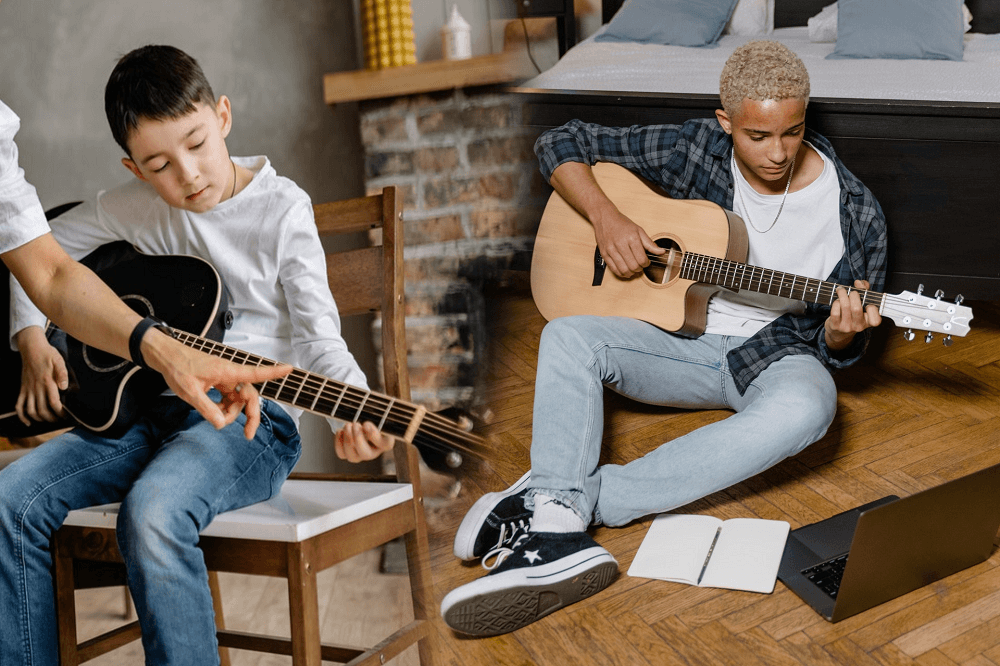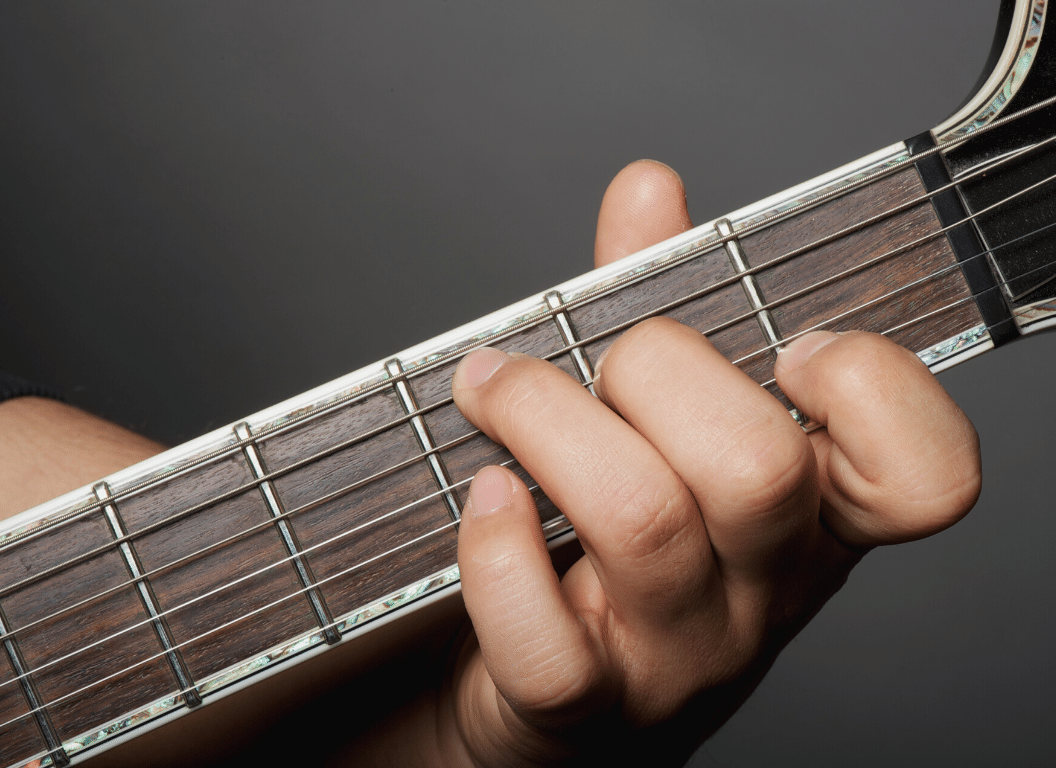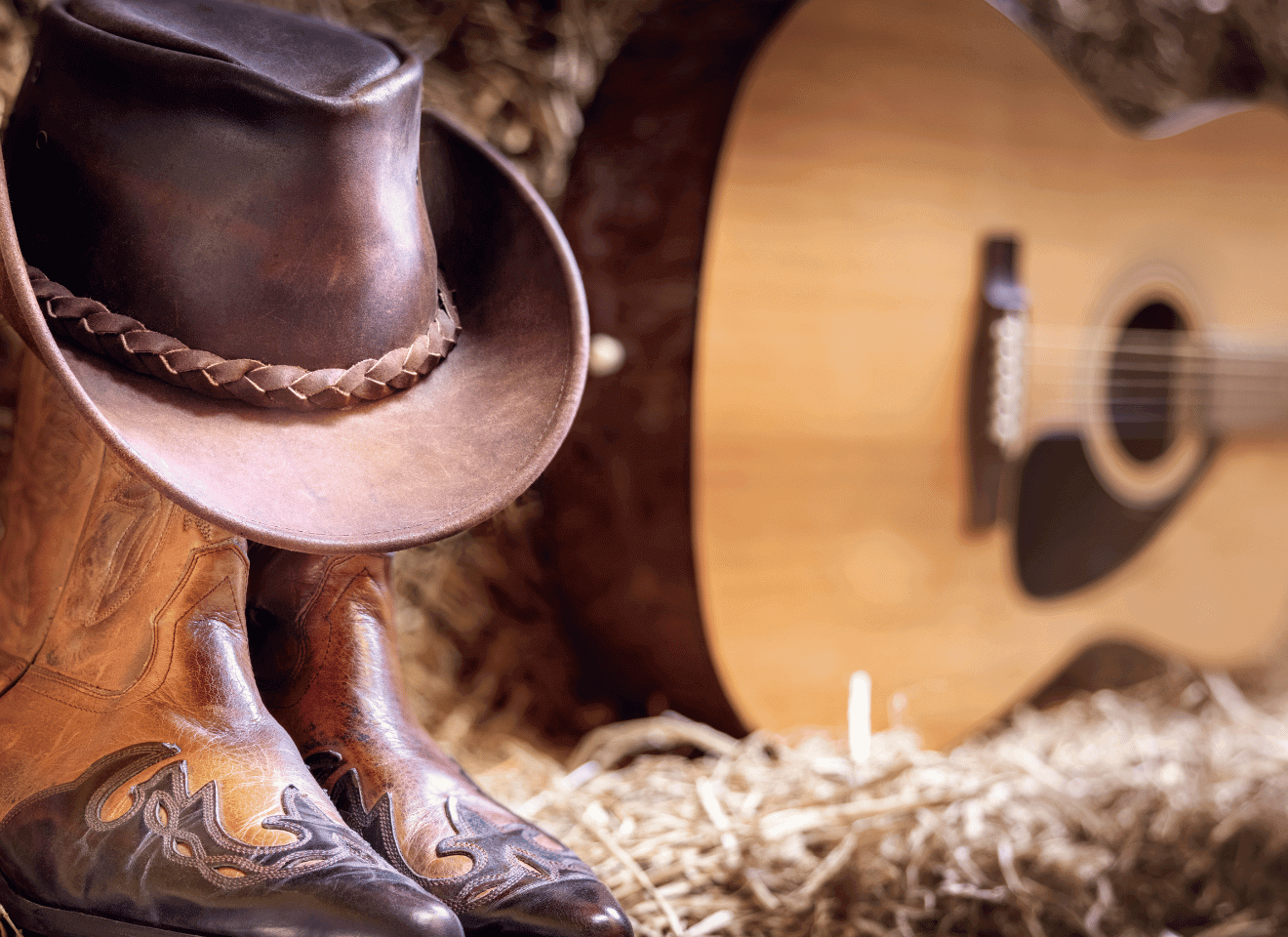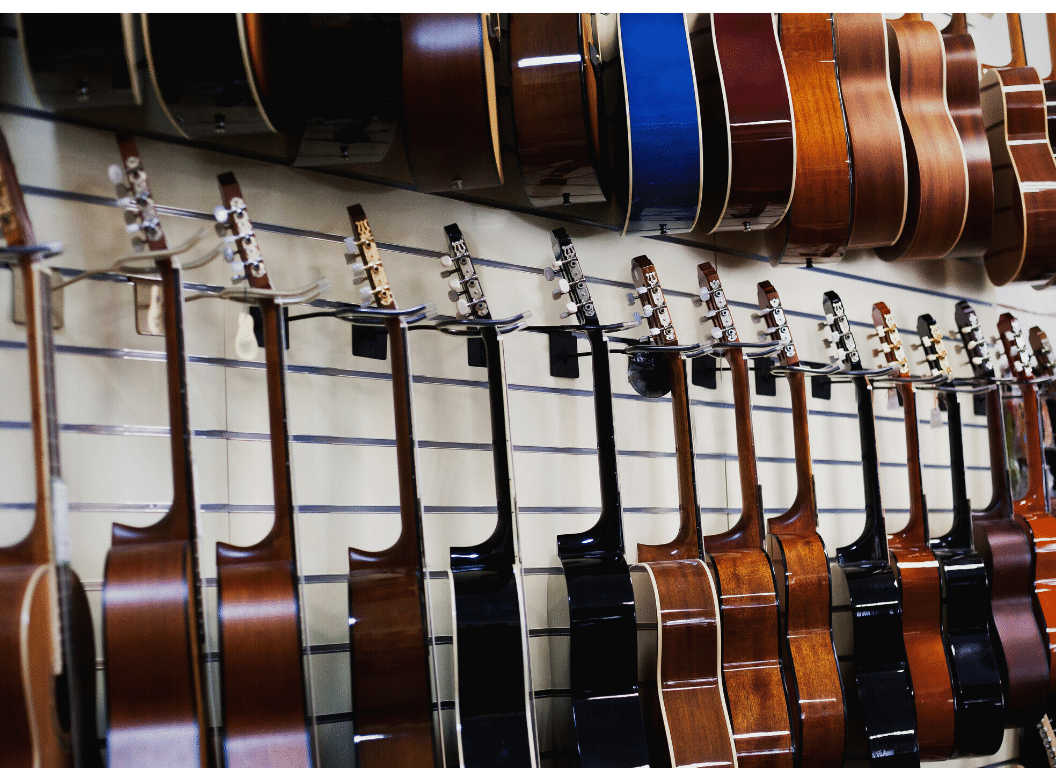Are you looking for the best guitar tips for beginners? Are you a guitar player struggling to improve your technique?
You’re not alone, there are many mistakes that we make when we’re first starting to learn to play this instrument, but the good news is, that we can prevent and fix them very quickly.
In this blog post, I’m going to share with you some essential guitar tips that will help you completely improve your playing technique and abilities.
So whether you’re just starting out or you’ve been playing for a while, these tips will help you take your guitar playing to the next level.
Let’s get started!
Table of Contents
- 20 Essential Guitar Tips For Beginners
- 1. Record yourself playing the guitar from the start
- 2. Use a metronome to maintain timing and accuracy
- 3. Practice with a guitar that is properly tuned
- 4. Keep your hand position consistent while playing
- 5. Learn chords in different positions on the fretboard
- 6. Set small goals that you can gradually achieve
- 7. Rehearse both standing up and sitting down
- 8. Play with other musicians
- 9. Learn barre chords, even if it takes you some time
- 10. Stretch and warm up your hands before playing
- 11. Develop calluses on your fingers
- 12. Take breaks when needed
- 13. Get a guitar that is comfortable for you to play
- 14. Change up your routine every now and then
- 15. Find a good teacher who can help you with your goals
- 16. Read up on guitar techniques, theory, and tips
- 17. Put your guitar where it’s always visible
- 18. Practice at a slow tempo and gradually increase speed over time
- 19. Take the time to practice regularly and consistently
- 20. Have fun with it and enjoy the process
20 Essential Guitar Tips For Beginners
1. Record yourself playing the guitar from the start
When you’re just starting out, it’s a good idea to record yourself playing the guitar and then go back to listen.
You’ll be able to pick up on any mistakes or flaws in your technique that you might not have noticed otherwise, so recording can give you an objective look at what you’re doing well and what needs work.
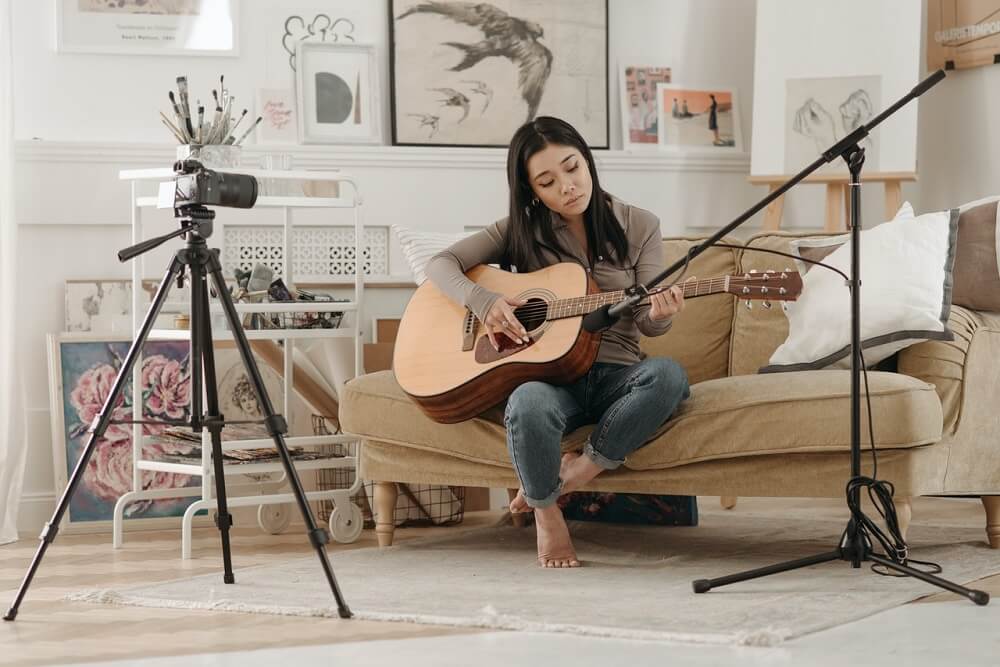
Also, I’d encourage you to do video before audio since you’ll be able to see exactly what your hands are doing as you’re playing.
On the other hand, in the long run, it’s always nice to have these files saved as a reference for your progress as a player.
2. Use a metronome to maintain timing and accuracy
A metronome is a great way to develop your timing and accuracy because it always keeps you in perfect time with the click or beep.
Every musician needs an internal clock that they can count on, and using a metronome is one of the best ways to build this sense.
You can use either a mobile app, or just simply search for “metronome” on Google, which should present you with a built in tool that’s very helpful and easy to use.

In addition, practicing regularly with a metronome will also help you increase your speed since it gives you something to push against.
As beginners, when we are starting to learn to play guitar, we tend to focus on what we play and that’s it.
Although there’s nothing wrong with that, if we want to be able to play guitar fluently, it’s important to not ignore this other side of the equation.
3. Practice with a guitar that is properly tuned
One of the most important things you can do as a beginner is practice with a guitar that is properly tuned.
If your guitar isn’t in tune, it will be difficult to make any progress since everything you play will sound off.
Fortunately, tuning your guitar is a relatively simple process and there are plenty of resources available online that can help.
You can either buy a tuner device or just use an app on your phone to tune your guitar.
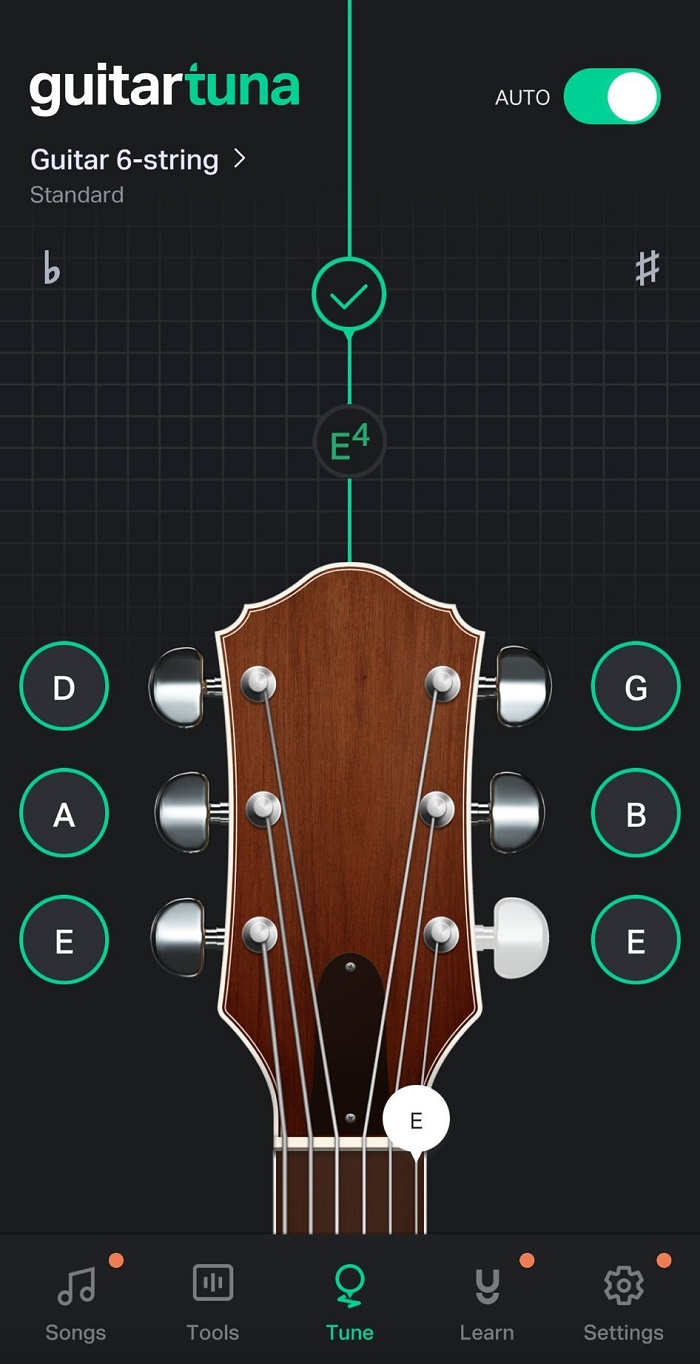
Both ways work just fine, so just use whatever is more convenient for you.
Check out our article on the best guitar tuners available that are actually worth checking out.
4. Keep your hand position consistent while playing
A common mistake beginners make is not keeping their hand position consistent while playing.
This can lead to all sorts of problems such as poor tone, inaccurate fretting, and even pain in your hands.
To avoid these issues, it’s important to always keep your hand position in the same place while you’re playing.
There’s no need to adjust your grip every time you move to a new fret or string, so find a comfortable position and stick with it.
When it comes to your picking hand, make sure that the angle in which you’re playing stays relatively similar every time.
I encourage you to watch this video by JustinGuitar in which he goes over 3 mistakes to avoid when holding your guitar:
Bad habits are difficult to let go of, so these are things you want to get right from the start.
With consistent and good practice, you’ll be able to gradually adjust your technique and improve over time.
5. Learn chords in different positions on the fretboard
When you’re just starting out, it can be tempting to only learn the basic chords.
However, once you’ve got those down, there are plenty of other chords that you’ll want to practice and master as well.
Not only will this increase your versatility as a guitarist, but it will also help you improve your technique and ability to move fluidly between different positions on the fretboard.
One of the best ways to do this is by using an app like Uberchord, ChordBank, or really any other guitar chord resource online.
These will show you how to play chords in different positions on the fretboard and help you learn new ones more easily.
For example, let’s take a look a some Am chord shapes across the fretboard:
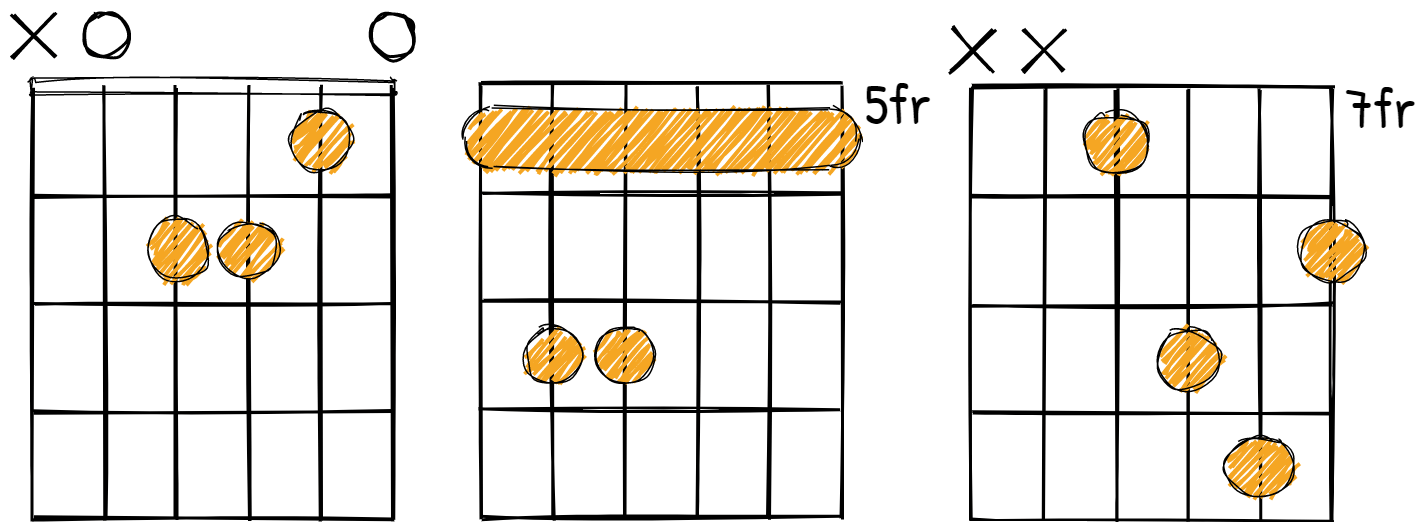
These are only 3 out of the many different shapes available, but as you can see, it would be very useful to know them for whenever you’re playing in those positions.
6. Set small goals that you can gradually achieve
As a beginner, it’s a good idea to set smaller goals for yourself that you can gradually achieve.
This will not only keep you motivated and encouraged, but it will also help prevent frustration and burnout in the long run.
For example, instead of trying to learn 20 songs right away, try learning one song at a time with small daily practice sessions.
Another great way to do this is by keeping track of your progress as you go along.
For example, instead of trying to learn an entire solo at once, maybe set at least 3 to 4 sections that you can work on and gradually piece together.
Before you even realize it, you’ll be playing the entire solo and it will feel great; at that point, you can just repeat the same process over and over.
7. Rehearse both standing up and sitting down
It’s very important to get used to playing guitar both standing up and sitting down.
This will help you develop good posture and positioning, as well as allow you to adjust your technique depending on what position you’re in.
In general, it’s a better idea to start off by practicing while sitting down since this is the most comfortable option for beginners.
As you progress in your skill level, however, it can be a great way to practice different techniques that require dynamic hand positions or picking motions.
Also, if you ever plan on playing in a band or performing in front of an audience, you’ll need to know how to play while standing.
This brings us to our next point…
8. Play with other musicians
Playing with other musicians is one of the best ways to improve your technique and practice new skills.
Whether you’re jamming in a band or just hanging out with friends, it’s very important to share your music and play with others.
Not only will this help keep you motivated and inspired, but it will also give you an opportunity to learn from others as well.

There are plenty of online communities that you can join if there aren’t any local groups near where you live, so don’t be shy about looking for them!
In my personal experience, this is the exact reason that pushed me to learn and get better at guitar.
This is because ideally, you’d want to play with people that are better than you, and that should encourage you to practice more and more.
9. Learn barre chords, even if it takes you some time
One of the most important skills you can learn as a guitarist is how to play barre chords.
This is because they’re used in nearly every popular song and musical style, so not learning them will limit your potential as a musician.
Barre chords allow you to play more complex and interesting songs and move around the fretboard more easily.
In the beginning, it may be difficult or even painful to press down all 6 strings at once, but don’t let that discourage you!
With enough practice and time, you’ll eventually be able to master these chords without any issues.
Until then, just take it slow and focus on making sure that each note sounds clean and clear.
Also, know that for any given chord, there’s always an easy shape that you can use.
For example, if you’re having trouble playing an F chord, try fretting or pressing only the first three notes of the chord.
10. Stretch and warm up your hands before playing
A big mistake that even I was guilty of was jumping straight into playing mode without ever stretching or warming up my hands before playing.
This can lead to strain and tension in your muscles, which will affect both how you play and how you feel.
Before playing, it’s always a good idea to stretch out your fingers and wrists so that they’re limber and ready for action.
Here’s a 5 minute stretch that will help you out tremendously if you’re looking to have good and productive practice sessions:
You can also just do some gentle wrist rolls or arm circles to warm up your body before starting a session.
If you start feeling any pain or discomfort as you play, take a break immediately!
This will help prevent injury and ensure that you have many years of enjoyable playing ahead of you.
11. Develop calluses on your fingers
Calluses are a normal part of learning to play guitar, and they’re actually a good thing.
This is because they help protect your fingertips from getting sore or cut while you play.
Over time, the skin on your fingers will build up and toughen up so that they can withstand more pressure and friction when pressed against the frets.
There’s no real way to speed up this process though, so just be patient and keep playing for as long as you can each day.
12. Take breaks when needed
Learning how to play guitar requires a lot of time and effort, so it’s very important that you always take breaks when needed.
This is because your muscles will start to get tired and sore after playing for long periods of time, which can affect both your technique and musical performance.
It’s also very easy to lose motivation if you practice for too long without any type of break or reward.
Short term breaks mean spending some time on your phone, grabbing some food to eat, or simply watching some TV.

Long term breaks are a bit different, since they usually span for about a week all the way until a full month.
I wouldn’t recommend taking long term breaks since they make it harder for you to learn and get back into playing mode, but they’re definitely an option if you feel overwhelmed.
The bottom line is, if you start feeling like you’re losing interest in playing guitar or getting frustrated, try taking a day off or two from practicing to refresh yourself before jumping back into it again.
13. Get a guitar that is comfortable for you to play
Another thing that most people ignore at first is the fact that you may want to make sure that your guitar is comfortable for you to play.
Ideally, you’d want something that’s light enough but still has a full tone so that it doesn’t sound like a toy when played.
Of course, this depends on whether you’re playing acoustic or electric guitar, but generally speaking, you’ll want to avoid anything that doesn’t feel comfortable to you.
Make sure that your guitar is big enough or small enough depending on your size, and that the strings aren’t too close together or too far apart.
You should also check to see if the action is too high or low, as this can affect how easy or difficult it is to play certain chords.
14. Change up your routine every now and then
While practicing guitar and learning new songs is great, it’s also important that you keep challenging yourself by changing up your routine every now and then.
This means that instead of playing the same old songs or techniques for too long, try mixing things up by working on other skills or trying out different genres.
Not only will this help maintain your interest in guitar, but it will also make sure that you’re not just repeating the same mistakes over and over again.
For example, lets say that your routine consists of learning chords to play certain songs, well, then you might want to experiment with different strumming patterns or fingerpicking techniques.
On the other hand, if you’ve been too technical and have just been reading about music theory for a while, is maybe time for you to play some of your favorite songs for a while.
Here are 5 great exercises for your practice routine that will surely help you out by improving your playing skills:
15. Find a good teacher who can help you with your goals
Finally, to really master the art of playing guitar and achieve your goals as a musician, it’s important that you find a good teacher who can help you every step of the way.
This is because having someone to guide you and give you feedback on your progress can make all the difference in terms of how quickly and easily you learn.
So if possible, try to work with a guitar instructor or take lessons from another experienced player who can offer useful advice based on their own experiences.
At the very least, find someone that knows more than you and can answer questions when needed.
Although this is not necessary, it can definitely be helpful, especially if you’re just starting out.
I personally only took about a handful of guitar classes, and then the rest was all me teaching myself through videos.
In the end, I learned to play the guitar, which was the goal, but having a teacher by your side will always beat learning by yourself.
16. Read up on guitar techniques, theory, and tips
This one is one of the most avoided topics among guitar players for some reason, but you need to take the time to study.
It’s extremely important that you learn as much as you can about the instrument.
This means reading up on different techniques, music theory, and tips from other players.
One of the best ways to do this is by finding online resources or books that cover these topics in detail.
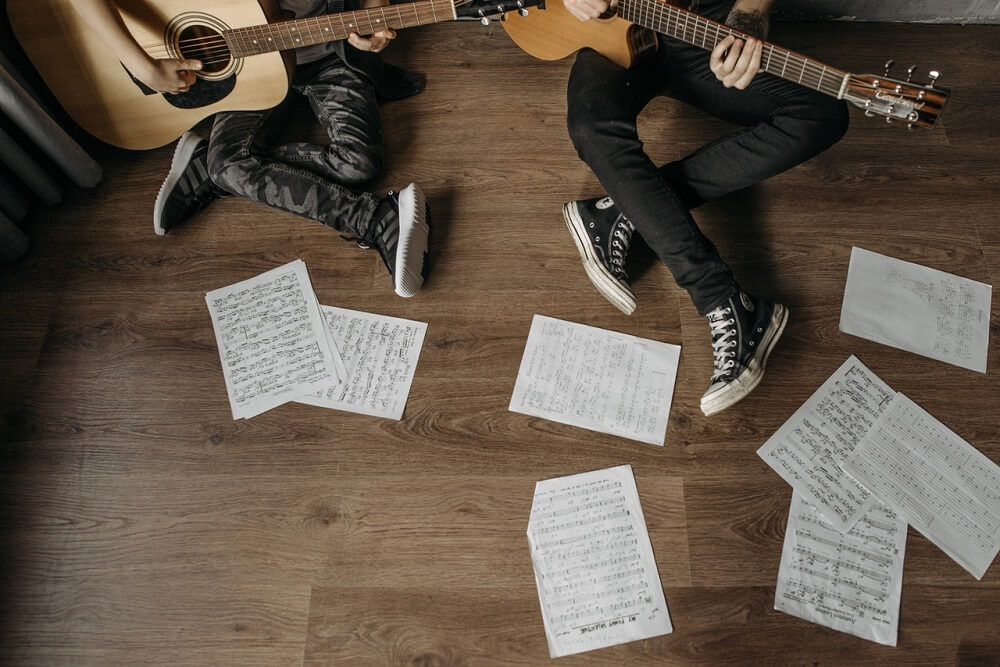
For example, if you want to learn about different strumming patterns, then search for a video or article that breaks them down step by step.
If you’re interested in learning more about music theory, then look for a book that explains things in a way that makes sense to you.
The more you know about guitar and music in general, the better equipped you’ll be to learn new skills, play new songs, and improve your overall playing ability.
Having a solid foundation of knowledge is definitely a big help!
17. Put your guitar where it’s always visible
This is one of the most simple, yet effective tips that I can give you or anyone that wants to learn to play guitar.
If your guitar is always within view, then you’ll be more likely to pick it up and play it.
This is because out of sight usually means out of mind!
So if your instrument is hidden away in a closet or tucked away in a corner somewhere, then there’s a good chance that you won’t even think about it until you need it.

But if it’s right there in front of you, then you’re much more likely to grab it when the mood strikes.
So whether you keep your guitar on a stand in your living room or hang it on the wall in your bedroom, just make sure that it’s always within easy reach.
18. Practice at a slow tempo and gradually increase speed over time
It’s not about how much you practice, but rather how well you practice.
Speed is a byproduct of accuracy, or so they say; Joe Satriani put it best when he said:
“Some of us are going to play faster than others. Hitting the right notes and getting your technique right is so much more important than speed.”
Because of this, it’s important that you practice at a slow tempo and gradually increase your speed as you get more comfortable playing a particular song or exercise.
This will ensure that each repetition feels good and is accurate, which will result in fewer mistakes overall.
On the other hand, if you try to play everything at a faster speed from the beginning, then you’ll probably end up making more mistakes and getting frustrated.
So take your time, build accuracy, and only increase speed once it feels comfortable.
19. Take the time to practice regularly and consistently
The best way to improve your guitar playing ability is by practicing regularly and consistently.
This means taking the time to play every day, even if it’s just for a few minutes.
The more you play, the better you’ll get and the faster you’ll progress.
Of course, this also requires some level of dedication and commitment on your part.
But if you’re serious about learning to play the guitar, then it’s definitely worth putting in the time and effort.
20. Have fun with it and enjoy the process
This is definitely the most important thing to remember!
Learning to play the guitar can be challenging, but it’s also a lot of fun, so make sure to enjoy yourself along the way and don’t get too caught up in the details.
It’s important to have a great time with it and enjoy the process, playing guitar should be enjoyable, so don’t make it into a chore.
If you’re not enjoying yourself, then there’s a good chance that you’ll give up before you ever really get started.
So find music that you enjoy, practice regularly, and always keep learning new things, soon enough, you’ll be rocking out like a pro!

More than 10 years of experience playing and writing about guitars! When not writing, I can be found strumming away some Johnny Cash tunes. Favorite all time guitar is the Gibson Les Paul. #TeamGibson

